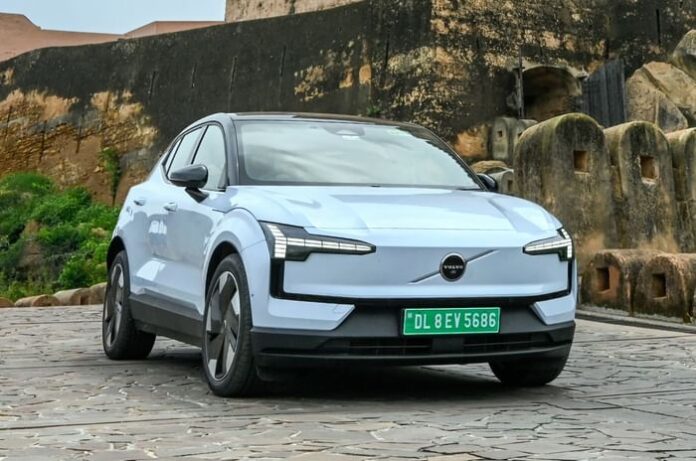Volvo’s upcoming EV is big on style and even bigger on sustainability. But will it sustain in the cutthroat Indian market?
Volvo is planning to enter the competitive Rs 50 lakh luxury EV segment with an all-new car – the EX30. The aim is to attract younger buyers while offering a premium badge backed by a strong environmentally conscious approach. But can it achieve that? Or is the EX30 perhaps a bit too European for the Indian market?
2025 Volvo EX30 exterior design and engineering: 8/10
Modern design language but with Volvo DNA and subtlety
| Volvo EX30 dimensions | |
|---|---|
| Length | 4233mm |
| Width | 1940mm |
| Height | 1550mm |
| Wheelbase | 2650mm |
| Ground clearance (unladen) | 171mm |
| Turning circle | 10.6 meters |
| Kerb weight | 1775kg |
The EX30 is Volvo’s first ground-up EV built on the Geely-owned SEA2 (Sustainable Experience Architecture) platform. Dimensionally, it is smaller in length, height and width compared to Volvo’s next EV, the EX40. However, with no ICE counterpart to rely on, the styling is brand new and integrates the EV bits a lot better.
With no ICE counterpart, the EX30 integrates the EV design bits a lot better.
Up front, it carries over the Thor’s hammer LED daytime running lamps, but with individual elements. The front, otherwise, remains closed off in typical EV fashion, with vents in the sides that help with airflow. An active air flap is at the bottom of the bumper.
As for the side, you have 19-inch alloy wheels that look bigger in person and a shorter wheelbase than Volvo’s other EVs. What is interesting is the roofline and the form factor, which stray away from the traditional boxy SUV look and adopt a more new-age design. Ground clearance is good, too, and there is no visible battery pack under the car since it has been tucked away into the floor.
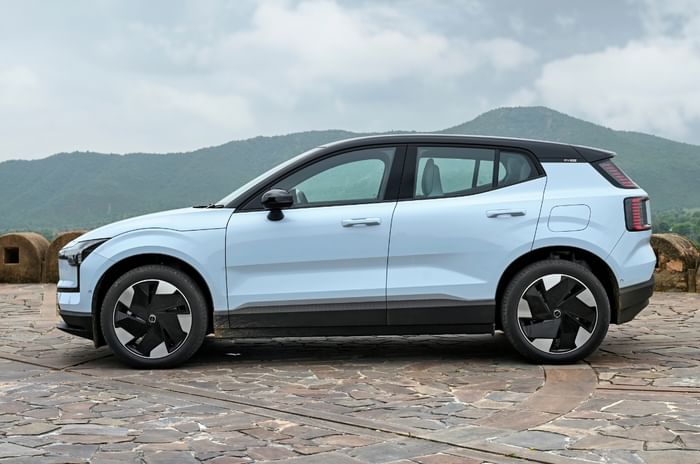
It doesn’t have a traditional boxy SUV look and adopts a more new-age design.
The rear features C-shaped LED tail-lamps with elements that extend on the rear windshield. Also, the rear is fuss-free and a bit more restrained in comparison to the funky front.
Interestingly, getting inside can be done in a fully digital manner, using your phone or a smart card that you need to tap on the driver’s side B-pillar.
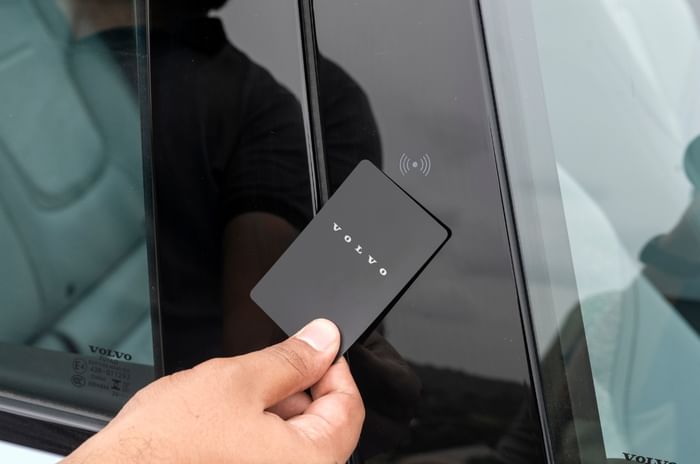
A tap of the smart card on the driver’s side B-pillar allows entry into the car.
2025 Volvo EX30 interior space and comfort: 6/10
Big on sustainability but lacks space and some key features
Inside, the first thing you notice is the upholstery, which is not luxurious in the traditional sense, but there is solace in the fact that you are doing your best to help the earth. The dashboard is layered with recycled materials, with the only metal being on the vents or door handles.
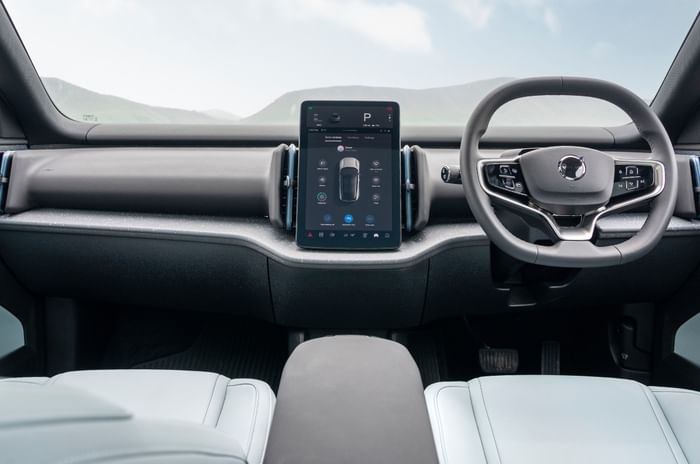
The dashboard is layered with recycled materials, not leather like in most luxury cars.
Also noticeable is the raised floor that results in a knees-up sitting position even for the front passenger. What’s nice is that the seats are broad and comfy, and the driver’s seat gets power adjustment as well. Sadly, it misses out on ventilation, heating or massaging, which is usually a highlight on Volvo cars.
Storage options are in abundance, with huge door pockets, a good amount of room in the lower half of the centre console, and cup holders that can be tucked away to open up access to the space below.
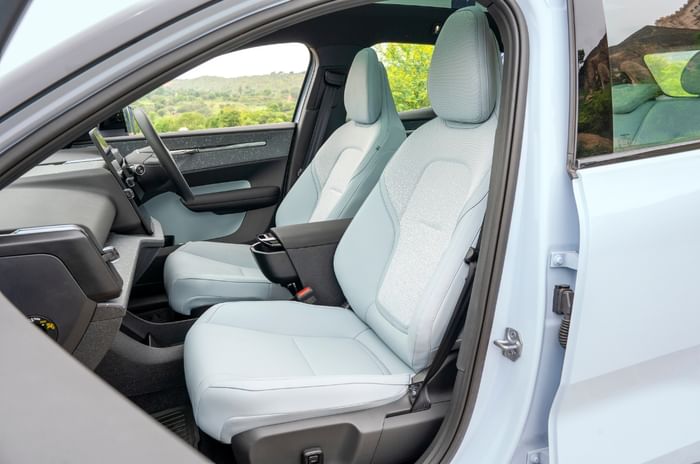
Front seats are broad and comfy but miss out on ventilation.
In the rear seat, space is tight, and adults taller than 6 feet will struggle for room. The floor height is significantly high, and while the floor itself is flat, the lack of under-thigh support and the knees-up seating rob comfort. Shorter adults won’t struggle as much and will be fine for short city drives.
Width is best suited only for two in the back, and while the seat comfort is good, the room is tight. The glass roof adds plushness, but with no blind or cover, it is bound to heat up the cabin on a hot day.

Rear seat has a knees-up seating position and isn’t ideal for those over 6 feet tall.
The boot, at 318 litres, is decent and accessible, and a unique touch is the diagram on the tailgate that shows what all it can fit. There’s also a 7-litre frunk, which will mostly be used up by the charging cable, and there is no spare wheel on offer.
2025 Volvo EX30 features and safety: 6/10
Most features controlled via screen; basics are missed
Taking centre stage is a 12.3-inch vertically mounted touchscreen that features all of the functions. There isn’t a single physical switch or button on the dashboard. Even adjusting the headlamps and outside rearview mirrors is done via the screens, and that takes some time to get used to. The screen itself uses Google software with a Snapdragon chip that makes it quick and responsive, and the default navigation is also Google Maps. Apple CarPlay is wireless, but the same does not go for Android Auto. There is a 360-degree camera too.
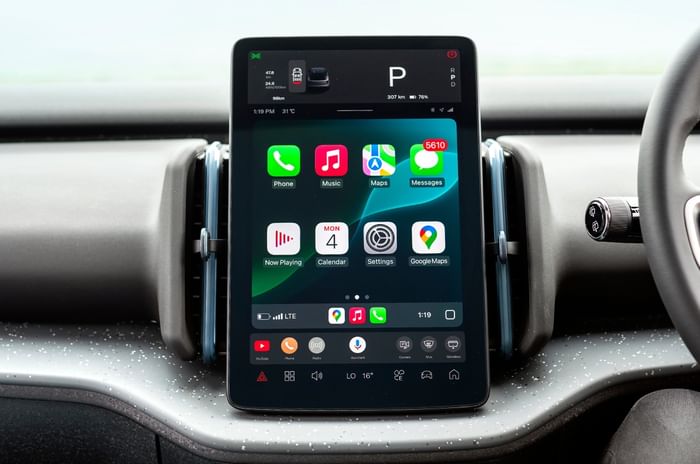
The touchscreen is the go-to place for all functions; no physical controls at all.
The lack of an instrument cluster means driving data is also embedded in the screen. There’s a dedicated section at the top of the screen for basic data like range, speed and ADAS notifications.
Audio duties are courtesy of a Harman Kardon soundbar that extends the width of the dashboard and features tweeters and a subwoofer behind the dashboard. While the audio quality is good, it does not match that of Volvo’s Bowers & Wilkins systems.
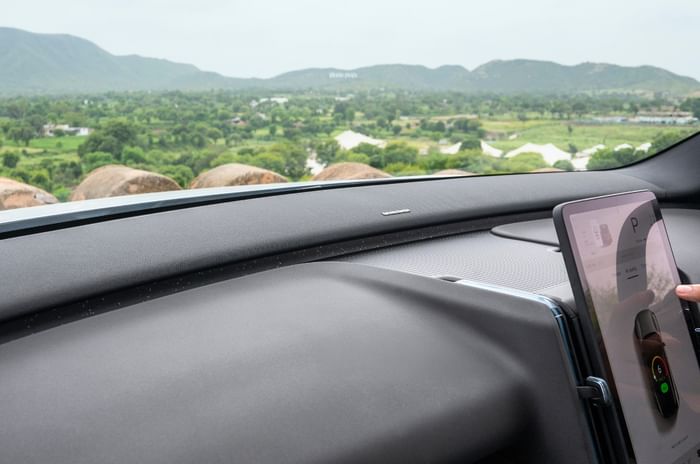
Harman Kardon soundbar extends the width of the dash, with tweeters and subwoofers behind.
In the rear seat, the EX30 misses out on AC vents and sunblinds, and there is no option to recline the backrest either. What it does get, though, is Level 2 ADAS, along with warnings for door opening and a drowsiness detector that scans your face, road and steering position.
2025 Volvo EX30 performance and refinement: 8/10
Good power, but drive is smooth and gentle
| Volvo EX30 battery and specs | |
|---|---|
| Battery size | 69kWh |
| Drive layout | Rear-wheel drive |
| Power | 272hp |
| Torque | 343Nm |
| 0-100kph (claimed) | 5.7 seconds |
| Top Speed (claimed) | 180kph |
This EX30 is the Extended Range version featuring a 69kWh battery with NMC cells that are energy-dense and have longer life cycles. The battery puts out 272hp and 343Nm, is liquid-cooled and gets an 8-year warranty. Globally, a smaller battery pack option with LFP cells is available as well.
Refinement-wise, the EX30 is quiet and relaxed, apart from slight road and wind noises at high speeds of about 100kph. Vibrations are very well-contained, and the road damping is quite nice, too.
Performance is nice and linear but not exciting.
Volvo claims 0-100kph in 5.7 seconds, but there is none of that neck-snapping response, and power delivery is linear, which makes it very easy to drive in day-to-day scenarios. Now, while that acceleration is nice and linear, you don’t have any drive modes to help you gain a bit more in terms of response – there’s a default setting. The same goes for regeneration as well; there is no selective regen on this car, so whatever recuperation happens is during braking. But it does have a one-pedal driving mode, which makes it effortless in bumper-to-bumper traffic. However, all this means the EX30 is not the most exciting car to drive, and all you can do from behind the driver’s seat is manage the steering wheel.
2025 Volvo EX30 mileage: 7/10
69kWh battery pack delivers a claimed 480km WLTP range
| Volvo EX30 range and charging | |
|---|---|
| Claimed range (WLTP) | 476km |
| 11kW AC charging (0-100 percent) | 7 hours |
| 150kW DC Charging (10-80 percent) | 25 mins |
And then, we come to the all-important topic of range – 480 kilometres is what Volvo claims on the WLTP cycle; obviously, real-world figures will be slightly different. At 95 percent, we were looking at about 360 km of range when we started the drive. Of course, that depends on the driving style and whether the drive is in the city or on the highway. On our shoot day, we drove mostly on the highways and not much in the city, so we weren’t able to get the most accurate number. That said, on a single charge, you can comfortably expect above 350 km, which is not too bad given that the car is likely to do mostly urban runs and, once in a while, small intercity commutes.
Volvo claims a range of 480km on the WLTP cycle.
The 400V battery architecture allows it to charge from 0 to 100 percent in 10 hours and 30 minutes when using a 7.4kW charger, in 7 hours with an 11kW AC charger and in just 25 minutes with a 150kW DC charger.
2025 Volvo EX30 ride and handling: 8/10
Stable ride with good damping, but not a fun handler
Speaking of ride comfort, there is an inherent firmness to the ride with all that weight low down, but the damping is really good, so over low speed bumps, even though you move about slightly, none of the harshness or thuds seep into the cabin.
The EX30 rides with an inherent firmness, but damping is really good.
But where that slight firmness in the suspension helps is in the corners, as the EX30 remains relatively firm and flat. There is minimal roll, and it is stable, but you won’t get much feedback from the steering, even though you have selectable modes – soft, medium and firm. The artificial heft added to the steering, especially in the firm setting, helps it feel sharp, but the soft setting is the most preferred one, as light steering in the city aids manoeuvrability.
2025 Volvo EX30 price and verdict: 6/10
Pricing will have to be aggressive to fight rivals
Pricing for the EX30 is likely to be aggressive and will undercut the EX40 and C40. In terms of the battery size, it will go up against the BMW iX1 LWB and Mercedes-Benz EQA, but with a price tag of around Rs 50 lakh, it will also have to fight some strong EVs like the Hyundai Ioniq 5, BYD Sealion 7 and even the Kia EV6, which pack a whole lot.
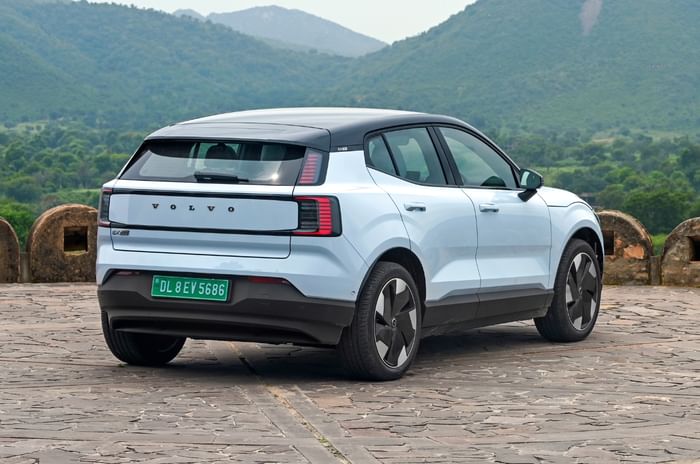
The Volvo falls short on rear seat space and misses some basic features, but its strong suits are its modern design, sustainable interior and the premium badge that will look to attract buyers. This SUV has several strengths but also has its work cut out.
Also see:
2025 Range Rover Sport SV India review: Peaky Blinder
MG Cyberster track drive: Droptop delight
